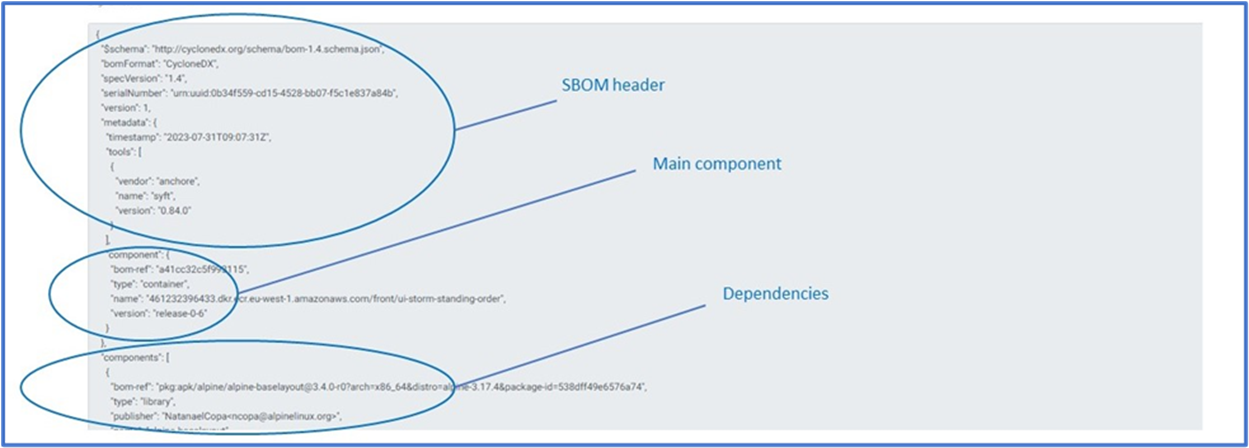Try Eracent’s SBOM-HQ™ at No Cost!
Your Headquarters for Complete SBOM Management and Analysis
Comprehensive SBOM Management and Analysis:
A Critical Component for Ensuring Software Supply Chain Security
Eracent SBOM-HQ™
Comprehensive SBOM Management and Analysis:
A Critical Component for Ensuring Software Supply Chain Security
Most commercial and custom software applications contain at least some open source code. Typical vulnerability analysis tools do not inspect the individual open source components within applications, although any of these may contain vulnerabilities or obsolete code that can put your organization at risk. The Log4j vulnerability that enabled the massive cybersecurity attack that spread to SolarWinds customers in 2020 is a perfect example.
Cyber Mandates and Directives
In response to ongoing breaches, multiple international organizations have developed mandates, directives, and guidelines to strengthen software supply chain security and minimize the threat of future attacks.
In the United States, Executive Order 14028 was issued in May 2021. This order defines security measures that must be followed by any software publisher or developer that does business with the federal government. Additionally, in December 2022, the signing of Section 3305 of the Consolidated Appropriations Act of 2023 authorized the Food and Drug Administration (FDA) to establish cybersecurity standards for medical devices.
In the European Union, the Network and Information Security (NIS) Directive established EU-wide legislation on cybersecurity. The subsequent NIS2 agreement, put into force in January 2023, obligates more entities and sectors to take measures to increase the level of cybersecurity in Europe.
Specific industries are also enacting guidelines, with the banking and financial sectors taking the lead. The New York State Department of Financial Services’ 23 NYCRR500 with Incorporated Second Amendment spells out requirements and compliance measures for financial institutions that are based in or doing business in the State of New York. In the EU, the Digital Operational Resilience Act (DORA) [Regulation (EU) 2022/2554] also defines uniform requirements concerning the security and risk management of network and information systems in the financial industry. These are just a few of the initiatives being developed and enacted.
One common element of each of these mandates is the use of the Software Bill of Materials, or SBOM.
What is an SBOM?
A Software Bill of Materials, or SBOM, is a file that provides an “ingredients list” of all libraries and components that make up an application. It shows the origin or DNA for each piece of code and is typically created by the publisher of the software.

SBOMs provide information that can help organizations solve challenges around:
- Vulnerability Management
- Open Source Software Risks, and
- Mandates and Directives.
Minimizing Open Source Software Risks
Using open source software introduces multiple types of risk to an organization:
- Vulnerabilities – Any library or component may contain potential vulnerabilities that provide access for hackers. Legacy vulnerability scanning tools do not look for potential issues “behind the scenes” within applications.
- Obsolescence – Older open source code may be obsolete and overlooked. Undermanaged code of this sort can also invite hacking activity.
- Licensing Risk – Open source code is licensed in numerous ways, defining how it may be utilized in software applications. Permissive licenses allow for the code to be used in many ways with few (or no) limitations. More restrictive license types, such as Strong CopyLeft, outline limitations of how the code may be utilized, what type of credit must be given to the developer, and more. If these conditions are not met, users may be forced to share their IP, or they may be subject to other legal and financial penalties.
While open source licensing is primarily a concern for commercial publishers and in-house application development teams, it is prudent for organizations acquiring third party software to review the SBOMs for products they plan to acquire to minimize the risk of problems appearing later around licensing. This is also a prime opportunity to check for potential vulnerabilities as well.
Eracent’s SBOM-HQ™
Eracent’s SBOM-HQ™ is a standalone module of the CyberMSuite™ (CSMS). SBOM-HQ™ provides a well-rounded set of data, reporting and analysis features that help organizations minimize risks and comply with cyber mandates and directives.
While SBOM-HQ™ provides value to in-house and commercial application development teams, it is also unique in its approach to meeting the requirements of organizations that purchase or subscribe to software from numerous publishers. These “software consumers” will have to manage dozens, hundreds, or even thousands of SBOMs for products that they use, and this is impractical or impossible to do one SBOM at a time.
SBOM-HQ™ is based around a centralized, single-source repository of libraries, components, and other related data from SBOMs. It dramatically reduces response time when a vulnerability is reported since it eliminates the need to review SBOMs individually.
How does SBOM-HQ™ work?
Customers upload their SBOM files via the user interface. During this straightforward process, users can assign related information that can be used to support reporting, filters, data access, and more. This information includes Publisher, Line of Business, Application Component, and more.
The SBOM-HQ™ “deconstructs” each uploaded SBOM and records the software product to which the SBOM belongs and all the SBOM’s content. This results in an index of components and libraries mapped to products. If a vulnerability is reported by NIST or another organization, customers get an immediate report of every product in use in their organization that includes the affected component or library.
SBOM-HQ™ is continuously monitored and updated, and it leverages vulnerability data from NIST and other trusted global sources. It uses this data to display risk scores, levels of criticality, and more.
SBOM-HQ™ also provides visibility into license types for each component and library, reducing the risk of unknowingly using a library that has excessive restrictions when less risky options are available. The system offers version tracking – the version in use, newer available versions, and version history – as well as lifecycle dates that support obsolescence management.
The dedicated open source library within Eracent’s IT-Pedia® product data library provides a solid foundation for SBOM-HQ™’s analysis and reporting.
Who can benefit from using SBOM-HQ?
SBOM-HQ is designed to support all teams engaged in the use and operation of software.
DevOps – SBOM-HQ integrates into CI/CD to generate and enrich SBOMs with real time risk data, ensuring secure and compliant releases.
Procurement – SBOM-HQ equips procurement teams with SBOM-driven insights into software quality and licensing risks, enabling smarter vendor selection and safer software purchases.
CyberSec teams – SBOM-HQ evaluates cyber security aspects of purchased software and monitors new vulnerabilities that appear.
ITOps – SBOM-HQ exposes software weaknesses and helps mitigate the risks.
Legal and Licensing teams – SBOM-HQ delivers clear visibility into open source licenses, flags conflicts early, and provides audit-ready compliance reports.
Why SBOM-HQ?
SBOM-HQ is designed to support software buyers and users, not just software publishers. While most SBOM solutions stop at the software development life cycle, SBOM-HQ goes further. It empowers software consumers to continuously monitor not only what they build, but also what they buy – from design and procurement, through integration, all the way to production in their own data centers. With SBOM-HQ, transparency extends beyond development, delivering visibility and control across the entire software supply chain.
To learn more about SBOM-HQ™, register for a free trial at Eracent.com or contact Eracent today!
519 Easton Road, P.O. Box 647
Riegelsville, PA 18077 USA
info@eracent.com
+1- 908-537-6520
eracent.com





